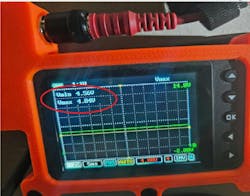Welcome back to another edition of “The data doesn’t lie,” a regular feature in which I pose a puzzling case study, followed by the answers to the previous issue’s puzzle.
This one comes from my good friend, Keith Perkins of L1 Automotive. Keith was invited to conduct technical training for another workshop and at the conclusion, asked the hosting shop’s personnel if there were any vehicles in their possession that he could demonstrate what was learned in class.
Today's Subject Vehicle
The suggested vehicle was 2013 Ford F-150 Platinum. And, the complaint was that the vehicle would start fine, but after a key-off event, the engine wouldn’t crank and the PCM would become completely unresponsive (Figure 1). There was a caveat, however. If the driver’s door was opened, communication was re-established upon the next key cycle and the engine would start just fine. This was a tremendous clue.
Step #1
Clearly, the PCM (like any electrical device) requires voltage and ground support to function (and many times a switched-ignition feed). With this in mind, Keith verified all three were present and accounted for at the PCM connectors. But there was a strange anomaly present. The switched-ignition feed would not drop to zero-volts during key-off. In fact, the voltage measured on the circuit was 5.1 volts (Figure 2).
Assembling the Puzzle
Typically, when a malfunctioning ECU has received adequate voltage, ground, ignition feed, and has good network integrity but still doesn’t communicate, it is faulty. That is just not the case in this instance. We almost never need to think about support voltage being present when it shouldn’t be. When the vehicle operated properly, that ambiguous “5V” was not present on the ignition-feed circuit during key-off. Opening the door was the key!
This is where it hit Keith like a ton of bricks. The vehicle had cut retained accessory power when the door was opened (Figure 3). This is where Keith needed to follow up next. It begs the question, what could cause a 5V presence on the switched-ignition circuit during key-off?
The Data Doesn’t Lie
With all the information in front of us, and the desired information not yet obtained, we are faced with deciding how to proceed. Here are some bullet points of what we know to be factual, and I will ask all of you, diligent readers, for your input on what they mean to you, collectively:
- An intermittent “no-crank” condition is present after certain key-off cycles
- PCM loses comm during the failure with no loss of supply voltage, ground, or ignition feed
- Whenever failure surfaces, the previous key-off left 5v present on the switched-ignition feed
- The “5V” would vanish following the opening of the driver’s door, along with the symptoms
Given this information, what would you do next?
- Replace the PCM
- Research the RAP wiring diagram for circuit isolation
- Replace the ignition switch
- Replace the retained accessory power (RAP) relay
About the Author
Brandon Steckler
Technical Editor | Motor Age
Brandon began his career in Northampton County Community College in Bethlehem, Pennsylvania, where he was a student of GM’s Automotive Service Educational program. In 2001, he graduated top of his class and earned the GM Leadership award for his efforts. He later began working as a technician at a Saturn dealership in Reading, Pennsylvania, where he quickly attained Master Technician status. He later transitioned to working with Hondas, where he aggressively worked to attain another Master Technician status.
Always having a passion for a full understanding of system/component functionality, he rapidly earned a reputation for deciphering strange failures at an efficient pace and became known as an information specialist among the staff and peers at the dealership. In search of new challenges, he transitioned away from the dealership and to the independent world, where he specialized in diagnostics and driveability.
Today, he is an instructor with both Carquest Technical Institute and Worldpac Training Institute. Along with beta testing for Automotive Test Solutions, he develops curriculum/submits case studies for educational purposes. Through Steckler Automotive Technical Services, LLC., Brandon also provides telephone and live technical support, as well as private training, for technicians all across the world.
Brandon holds ASE certifications A1-A9 as well as C1 (Service Consultant). He is certified as an Advanced Level Specialist in L1 (Advanced Engine Performance), L2 (Advanced Diesel Engine Performance), L3 (Hybrid/EV Specialist), L4 (ADAS) and xEV-Level 2 (Technician electrical safety).
He contributes weekly to Facebook automotive chat groups, has authored several books and classes, and truly enjoys traveling across the globe to help other technicians attain a level of understanding that will serve them well throughout their careers.



